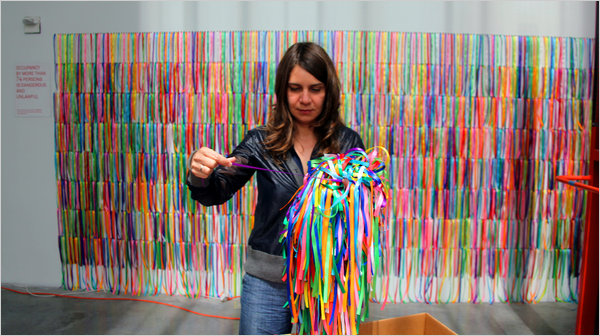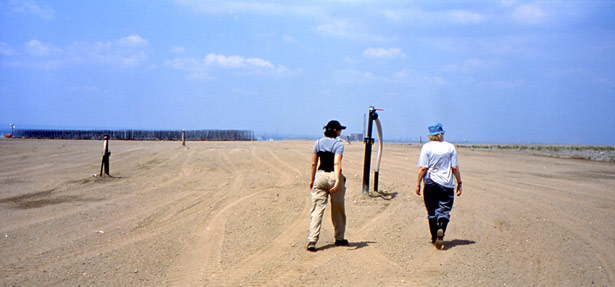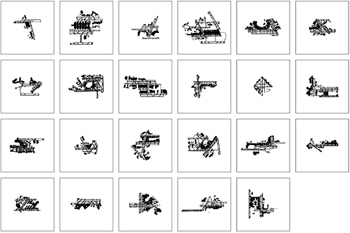March 5 – May 5, 2010
Pratt Manhattan Gallery
144 West 14th Street, 2nd floor
New York, NY 10011
http://www.pratt.edu
Pratt Manhattan Gallery presents “Envelopes,” an exhibition exploring new and sustainable potentials of the architectural surface in terms of the skin of a building and also as a sensorial space that envelops the body. “Envelopes” will feature full-scale, interactive models accompanied by architectural renderings in the form of drawings and computer animations, and documentation of the process of investigation into these models from eight international firms and designers. The exhibition will run from March 5 through May 5, 2010 and will be celebrated with an opening reception on Thursday, March 4 from 6–8 PM. The exhibition and opening reception are free and open to the public.
“Envelopes” is guest curated by Christopher Hight, an associate professor at Rice University’s School of Architecture. At Rice, Hight pursues design research on the nexus of landscape, ecology, and emerging forms of urbanization. He is the co-editor of AD: Collective Intelligence in Design (Academy Press, 2006), Heterogeneous Space (Wiley, 2009), and has recently published a book on cybernetics, posthumanism, formalism, and post-World War II architectural design titled Architectural Principles in the Age of Cybernetics (Routledge, 2008).
Hight conceived of “Envelopes” as a way to explore architectural skin as a site for enveloping nature and culture, object and subject, and of problematizing the boundary of interior and exterior. “Issues of sustainability and ecology raise many conceptual and design issues about the nature of the boundary between body, building, and larger environments,” said the curator. “The architects in ‘Envelopes’ are all exploring relationships between systems—human, animal, plant, and energy flow—as a site for architectural innovation in the 21st century,” he added.
Hight’s inspiration for the exhibition title and concept originated from parallels between the envelope of a building and the envelope of human skin; the building envelope repeats the metaphor of the building as a body and as a prosthetic second skin that allows human beings to exist within a hostile environment.
Inspired by early 20th century biologist Jacob von Uexkull and his interest in how living beings relate to and perceive their environment, the title of the show refers to the role of the building envelope and the idea of envelopment of one’s body and senses within a larger environment.
Participating architects and architecture firms include:
!ndie Architecture, a Denver-based firm that engages in a range of architectural and urban questions through research projects and practice, with a specialization in digital and industrial technology, housing, and suburbanism; Future Cities Lab, an interdisciplinary design and research collaborative bridging architecture and landscape urbanism with material sciences, robotics, and engineering HouMinn Practice, a Houston-based firm recognized for its research and innovative design whose collaborative efforts reach beyond the discipline of architecture; Mary Ellen Carroll/MEC design studios, a New York-based conceptual artist; Michael U. Hensel and Defne Sunguroğlu Hensel are research directors and board members at OCEAN, an the international, interdisciplinary, and independent research firm that conducts research by design in the intersection between architecture, design, music, and science with the goal of improving the current built enviro nment and anthropobiosphere; Philippe Rahm, an architect who practices out of Paris and Lausanne and focuses on ‘meterological’ architecture; servo, an international research and design collaborative that focuses on the development of architectural environments through the proliferation of electronic and digital equipment and interfaces; Weathers, a Chicago-based environmental design office that studies social, spatial, and organizational structures and their implications to lifestyle and environment.
“Envelopes” is made possible by part by grants from the National Endowment for the Arts; with public funds from the New York State Council on the Arts, a state agency; and the Cultural Services of the French Embassy in the United States.
For information, call 212-647-7778 or email exhibits [at] pratt [dot] edu or visit http://pratt.edu/exhibitions
Add Pratt Manhattan Gallery on Facebook by searching “Pratt Manhattan Gallery” and follow Pratt Exhibitions on Twitter at “PrattGallery.”




